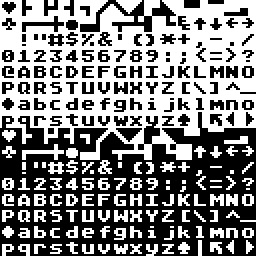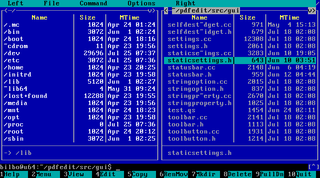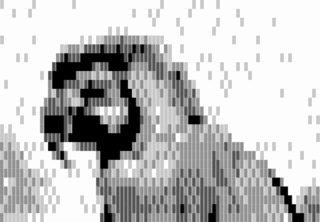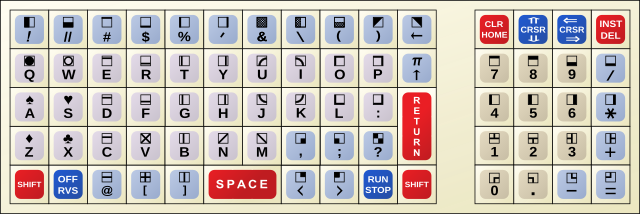
ASCII, an acronym for American Standard Code for Information Interchange, is a character encoding standard for electronic communication. ASCII codes represent text in computers, telecommunications equipment, and other devices. Because of technical limitations of computer systems at the time it was invented, ASCII has just 128 code points, of which only 95 are printable characters, which severely limited its scope. Modern computer systems have evolved to use Unicode, which has millions of code points, but the first 128 of these are the same as the ASCII set. ASCII is a 7 bit character set at heart, however is frequently rounded up to 8 bits to complete the full byte.

The ATASCII character set, from ATARI Standard Code for Information Interchange, alternatively ATARI ASCII, is a character encoding used in the Atari 8-bit home computers. ATASCII is based on ASCII, but is not fully compatible with it.

Michael Everson is an American and Irish linguist, script encoder, typesetter, type designer and publisher. He runs a publishing company called Evertype, through which he has published over one hundred books since 2006.

ArmSCII or ARMSCII is a set of obsolete single-byte character encodings for the Armenian alphabet defined by Armenian national standard 166–9. ArmSCII is an acronym for Armenian Standard Code for Information Interchange, similar to ASCII for the American standard. It has been superseded by the Unicode standard.

Box-drawing characters, also known as line-drawing characters, are a form of semigraphics widely used in text user interfaces to draw various geometric frames and boxes. These characters are characterized by being designed to be connected horizontally and/or vertically with adjacent characters, which requires proper alignment. Box-drawing characters therefore typically only work well with monospaced fonts.
T.51 / ISO/IEC 6937:2001, Information technology — Coded graphic character set for text communication — Latin alphabet, is a multibyte extension of ASCII, or more precisely ISO/IEC 646-IRV. It was developed in common with ITU-T for telematic services under the name of T.51, and first became an ISO standard in 1983. Certain byte codes are used as lead bytes for letters with diacritics (accents). The value of the lead byte often indicates which diacritic that the letter has, and the follow byte then has the ASCII-value for the letter that the diacritic is on.
MouseText is a set of 32 graphical characters designed by Bruce Tognazzini and first implemented in the Apple IIc. They were then retrofitted to the Apple IIe forming part of the Enhanced IIe upgrade. A slightly revised version was then released with the Apple IIGS.
The Basic Latin Unicode block, sometimes informally called C0 Controls and Basic Latin, is the first block of the Unicode standard, and the only block which is encoded in one byte in UTF-8. The block contains all the letters and control codes of the ASCII encoding. It ranges from U+0000 to U+007F, contains 128 characters and includes the C0 controls, ASCII punctuation and symbols, ASCII digits, both the uppercase and lowercase of the English alphabet and a control character.

Extended ASCII is a repertoire of character encodings that include the original 96 ASCII character set, plus up to 128 additional characters. There is no formal definition of "extended ASCII", and even use of the term is sometimes criticized, because it can be mistakenly interpreted to mean that the American National Standards Institute (ANSI) had updated its ANSI X3.4-1986 standard to include more characters, or that the term identifies a single unambiguous encoding, neither of which is the case.
KPS 9566 is a North Korean standard specifying a character encoding for the Chosŏn'gŭl (Hangul) writing system used for the Korean language. The edition of 1997 specified an ISO 2022-compliant 94×94 two-byte coded character set. Subsequent editions have added additional encoded characters outside of the 94×94 plane, in a manner comparable to UHC or GBK.

The ZX Spectrum character set is the variant of ASCII used in the ZX Spectrum family computers. It is based on ASCII-1967 but the characters ^, ` and DEL are replaced with ↑, £ and ©. It also differs in its use of the C0 control codes other than the common BS and CR, and it makes use of the 128 high-bit characters beyond the ASCII range. The ZX Spectrum's main set of printable characters and system font are also used by the Jupiter Ace computer.

Text-based semigraphics, pseudographics, or character graphics is a primitive method used in early text mode video hardware to emulate raster graphics without having to implement the logic for such a display mode.

The ZX81 character set is the character encoding used by the Sinclair Research ZX81 family of microcomputers including the Timex Sinclair 1000 and Timex Sinclair 1500. The encoding uses one byte per character for 256 code points. It has no relationship with previously established ones like ASCII or EBCDIC, but it is related though not identical to the character set of the predecessor ZX80.

The Atari ST character set is the character set of the Atari ST personal computer family including the Atari STE, TT and Falcon. It is based on code page 437, the original character set of the IBM PC.
The Acorn RISC OS character set was used in the Acorn Archimedes series and subsequent computers from 1987 onwards. It is an extension of ISO/IEC 8859-1, similar to the Windows CP1252 in that many of the added characters are typographical punctuation marks.
MSX character sets are a group of single- and double-byte character sets developed by Microsoft for MSX computers. They are based on code page 437.
The TRS-80 computer manufacturered by Tandy / Radio Shack contains an 8-bit character set. It is partially derived from ASCII, and shares the code points from 32 - 95 on the standard model. Code points 96 - 127 are supported on models that have been fitted with a lower-case upgrade.
This article covers technical details of the character encoding system defined by ETS 300 706 of the ETSI, a standard for World System Teletext, and used for the Viewdata and Teletext variants of Videotex in Europe.
Sharp MZ character sets are character sets made by Sharp Corporation for Sharp MZ computers. The European and Japanese versions of the software use different character sets.
The Amstrad CPC character set is the character set used in the Amstrad CPC series of 8-bit personal computers when running BASIC. This character set existed in the built-in "lower" ROM chip. It is based on ASCII-1967, with the exception of character 0x5E which is the up arrow instead of the circumflex, as it is in ASCII-1963, a feature shared with other character sets of the time. Apart from the standard printable ASCII range (0x20-0x7e), it is completely different from the Amstrad CP/M Plus character set. The BASIC character set had symbols of particular use in games and home computing, while the CP/M Plus character reflected the International and Business flavor of the CP/M Plus environment. This character set is represented in Unicode as of the March 2020 release of Unicode 13.0, which added symbols for legacy computing. The three missing characters have however been accepted for inclusion in Unicode 16.0 in the symbols for legacy computing supplement.












